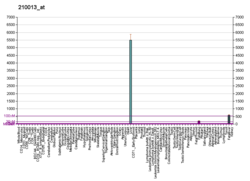Hemopexin (or haemopexin; Hpx; Hx), also known as beta-1B-glycoprotein, is a glycoprotein that in humans is encoded by the HPX gene[5][6][7] and belongs to the hemopexin family of proteins.[8] Hemopexin is the plasma protein with the highest binding affinity for heme.[9]
Hemoglobin itself circulating alone in the blood plasma (called free hemoglobin, as opposed to the hemoglobin situated in and circulating with the red blood cell.) will soon be oxidized into met-hemoglobin which then further disassociates into free heme along with globin chain. The free heme will then be oxidized into free met-heme and sooner or later the hemopexin will come to bind free met-heme together, forming a complex of met-heme and hemopexin, continuing their journey in the circulation until reaching a receptor, such as LRP1, on hepatocytes or macrophages within the spleen, liver and bone marrow.[10]
Hemopexin's arrival and subsequent binding to the free heme not only prevent heme's pro-oxidant and pro-inflammatory effects but also promotes free heme's detoxification.[10]
Hemopexin is different from haptoglobin, the latter always binds to free hemoglobin.[11][10] (See Haptoglobin § Differentiation with hemopexin)
- ^ a b c GRCh38: Ensembl release 89: ENSG00000110169 – Ensembl, May 2017
- ^ a b c GRCm38: Ensembl release 89: ENSMUSG00000030895 – Ensembl, May 2017
- ^ "Human PubMed Reference:". National Center for Biotechnology Information, U.S. National Library of Medicine.
- ^ "Mouse PubMed Reference:". National Center for Biotechnology Information, U.S. National Library of Medicine.
- ^ "Entrez Gene: HPX hemopexin".
- ^ Altruda F, Poli V, Restagno G, Silengo L (1988). "Structure of the human hemopexin gene and evidence for intron-mediated evolution". Journal of Molecular Evolution. 27 (2): 102–8. Bibcode:1988JMolE..27..102A. doi:10.1007/BF02138368. PMID 2842511. S2CID 11271490.
- ^ Altruda F, Poli V, Restagno G, Argos P, Cortese R, Silengo L (June 1985). "The primary structure of human hemopexin deduced from cDNA sequence: evidence for internal, repeating homology". Nucleic Acids Research. 13 (11): 3841–59. doi:10.1093/nar/13.11.3841. PMC 341281. PMID 2989777.
- ^ Bode W (June 1995). "A helping hand for collagenases: the haemopexin-like domain". Structure. 3 (6): 527–30. doi:10.1016/s0969-2126(01)00185-x. PMID 8590012.
- ^ Tolosano E, Altruda F (April 2002). "Hemopexin: structure, function, and regulation". DNA and Cell Biology. 21 (4): 297–306. doi:10.1089/104454902753759717. PMID 12042069.
- ^ a b c "Intravascular hemolysis". eClinpath. Retrieved 2019-05-08.
- ^ "Bilirubin and hemolytic anemia". eClinpath. Retrieved 2019-05-08.





